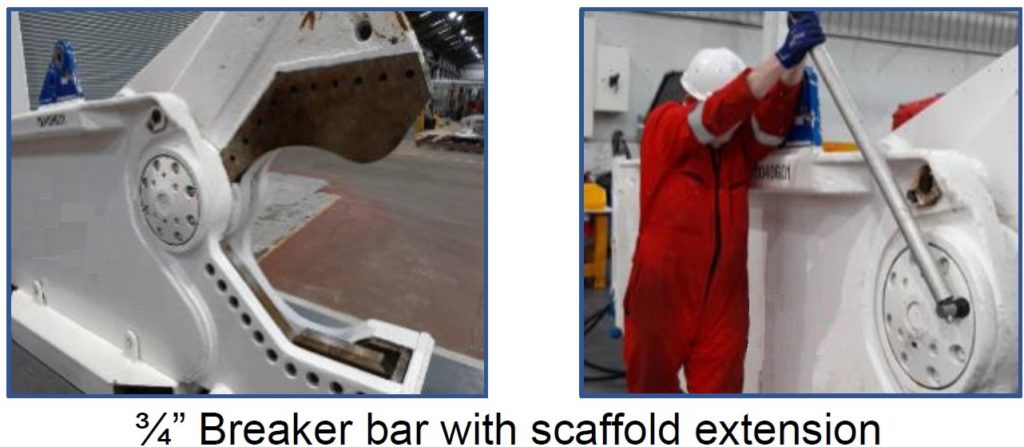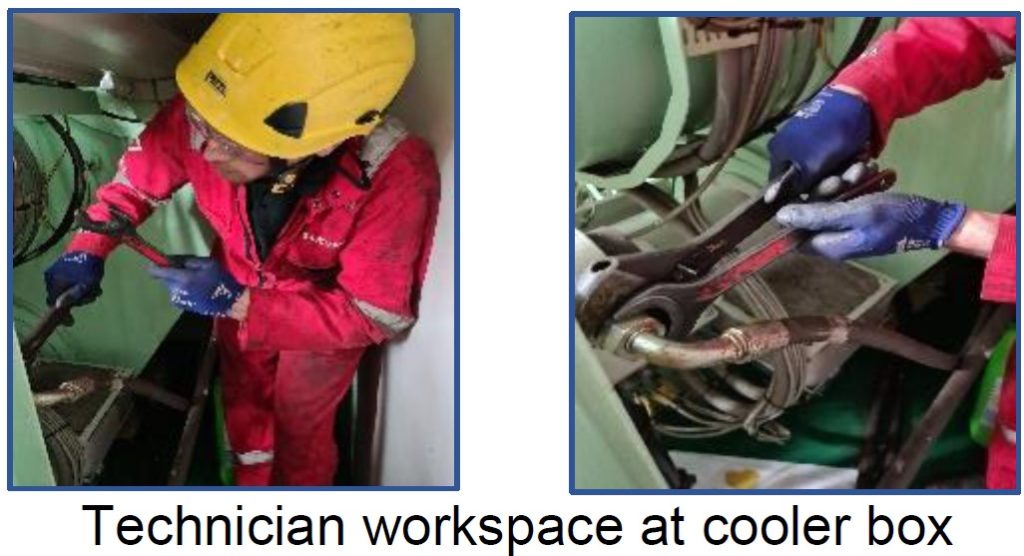Injuries sustained during maintenance – worker positioning
A member has noted several injuries in the last 6-8 months relating to worker positioning and the use of tools and equipment. A review of these incidents has established a need for improved risk assessments which consider the relationship between the worker, their environment, tools, and activity. We call this the ergonomics of the task.
What happened
In two cases where hand tools were being used, injuries resulted from not fully identifying the impact from the combination of the worker position, work environment and the tools, which created ergonomic challenges.
A technician was working on a hydraulic fitting with two spanners when one spanner slipped and struck him in the face. There was limited space available due to the position of the fitting. Holding one spanner in his right hand, he was loosening the fitting with a spanner in his left hand which slipped and struck his forehead causing the injuries. He was wearing safety glasses at the time but the struck safety glasses injured the bridge of his nose.
In another case a technician was using a cutting shear to break M20 bolts. While doing so he felt a twinge on his shoulder but continued to complete his shift. Further medical assessment later confirmed a significant muscle tear requiring treatment and rehabilitation.


Actions
Work in the marine and offshore environment may require individuals to lift, stoop, kneel, twist, grip, stretch, reach overhead, or work in other awkward positions. In planning these activities, task risk assessments, pre-job planning and toolbox talks should consider and review the combination of ergonomic factors that could impact the task.
Our member provides the following examples as a guide to support and develop worksite task risk assessments and activities.
| Type of control | Example |
| Engineering Controls Implement physical change to the workplace, which eliminates/reduces the hazard on the job/task | • Use lifting equipment and reposition heavy objects to limit force exertion • Reduce the weight of a load to limit force exertion • Reposition to workshop where possible to eliminate a long/excessive reach and enable working in neutral postures • Select tools to enable neutral postures and reduce forces |
| Administrative and Work Practice Controls Establish efficient processes or procedures | • Require that where necessary and there are no alternative heavy loads are only lifted by two people to limit force exertion • Review workspace restrictions where equipment or fittings are located • Establish systems to minimize the duration of continual exertion, repetitive motions, and awkward postures. Rotate employees across tasks that use different muscle groups whenever practical • Properly inspect, maintain, and use power/hand tools |
| Personal Protective Equipment Use protection to reduce exposure to ergonomics-related risk factors | • Ensure “Top to Toe” assessment is made to review risk to work teams • Limit direct contact with hard, sharp, or vibrating surfaces • Wear approved PPE to help with grip, slip resistance, cold/hot conditions while maintaining the dexterity to operate tools and handle items easily |
Safety Event
Published: 20 May 2021
Download: IMCA SF 14/21
IMCA Safety Flashes
Submit a Report
IMCA Safety Flashes summarise key safety matters and incidents, allowing lessons to be more easily learnt for the benefit of all. The effectiveness of the IMCA Safety Flash system depends on Members sharing information and so avoiding repeat incidents. Please consider adding [email protected] to your internal distribution list for safety alerts or manually submitting information on incidents you consider may be relevant. All information is anonymised or sanitised, as appropriate.
IMCA’s store terms and conditions (https://www.imca-int.com/legal-notices/terms/) apply to all downloads from IMCA’s website, including this document.
IMCA makes every effort to ensure the accuracy and reliability of the data contained in the documents it publishes, but IMCA shall not be liable for any guidance and/or recommendation and/or statement herein contained. The information contained in this document does not fulfil or replace any individual’s or Member's legal, regulatory or other duties or obligations in respect of their operations. Individuals and Members remain solely responsible for the safe, lawful and proper conduct of their operations.
